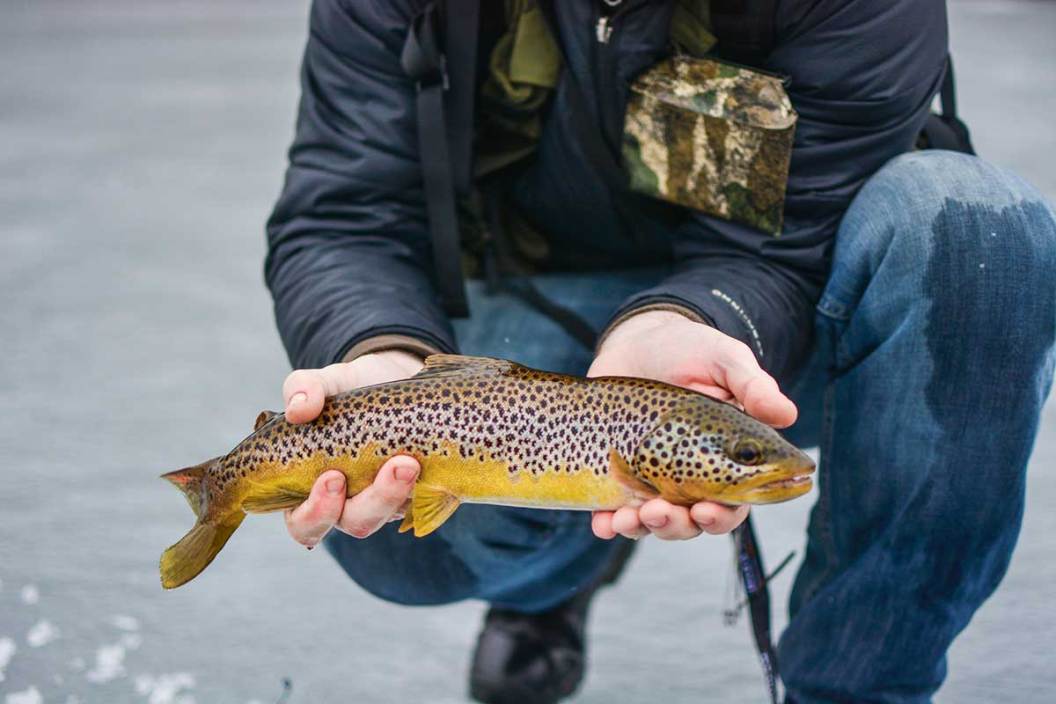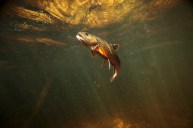What are the most popular species caught while ice fishing? We'll share our top three.
In most areas across the United States, the cold has come and the lakes are ready!
After the ice has been assessed and determined to be safe, it is time for get outside and go ice fishing!
Fishing through holes made in the ice of a frozen lake or river is a favorite activity of some anglers. There are many different varieties of fish that can be caught while ice fishing. Here is a break down of three of the most common and popular species caught while ice fishing.
Walleye
The walleye is a common freshwater fish native to Northern United States and Canada. Walleye get their name from the pearlescent appearance of their eyes, which is caused by the reflective coating that gives them the ability to see well in low-light and poor visibility conditions.
These elusive beauties prefer cool, deep, quiet waters of rivers, lakes, and reservoirs. Although walleye are mostly nocturnal, they are still commonly caught during the day. In daylight hours they are often found under the cover of fallen trees, boulders, and aquatic growth.
The largest member of the perch family, adult walleye typically range in weight from one to five pounds, but they can grow much larger in the right conditions. The Pennsylvania state record is a remarkable 18 pounds, 1 ounce walleye that measured 34 inches, caught from the Youghiogheny River in October 2021. The New York State record is a whooping 18 pounds, 2 ounce giant caught from the St. Lawrence River in 2018.
To catch walleye while ice fishing, try setting up over rocks or other underwater structures. Try a variety of methods, including jigs, Rapala lures, and live bait.
Trout
There are a few varieties of trout that are commonly caught while ice fishing - lake trout, rainbow trout, and brown trout. Trout are an active cold water species and can be a lot of fun to catch while ice fishing.
Lake trout are a native species that can grow to more than 30 inches long and weigh far more than ten pounds. The world record lake trout was a 72 pound lunker caught in 1995 in Great Bear Lake, Canada.
Lake trout can be identified by the white spots along the side over a background of bronze, silver, dark brown, or even green. They also have a deeply forked tail. Lake trout ice fishing can be quite productive on water depths between 10 and 100 feet with smelt, shiners, suckers, or silver, white, or copper jigs.
Rainbow trout are a gorgeous variety of trout that can are identified by a pink lateral stripe that starts just behind the eye. This stripe runs down the length of the fish all the way to the tail. Rainbows are silvery-gray to dark-green on the back and sides with a whitish-colored belly and small black spots that appear on the head and sides. The lower fins are pale-pink without spots.
Like other trout species, rainbows typically grow to around eight to ten pounds, but can be much larger, depending on habitat and sustenance. One of the largest recorded was a recent catch-and release caught in California in December 2021. That rainbow measured 41 inches long with a girth of 27 inches and an estimated weight of 38.2 pounds. That lunker will not be considered for a state record because it was released.
Rainbow trout are native only to the rivers and lakes west of the Rocky Mountains but has been widely introduced elsewhere in North America and beyond. They can be caught while ice fishing using a variety of jigging methods and artificial lures.
Brown trout are another variety of trout that can be ice fished using similar techniques as lake and rainbow trout. They are a separate kind of trout, however, and have some features that set them apart from their other trout relatives. Brown trout have a brown colorization with brownish and black spots along their sides.
Northern Pike
Northern Pike is another popular species targeted by ice anglers. They are an aggressive species that put up a hard fight, making them a lot of fun for fishermen.
Northern Pike are identified by an elongated body with a dark green to brown coloration with light colored spots along the sides. Pike have a mouthful of sharp, pointy teeth. Because of these teeth, it is important to use a wire leader while ice fishing for Pike. Other members of this fish family include muskellunge and pickerel.
Products featured on Wide Open Spaces are independently selected by our writers and editors. However, when you buy something through our links, we may earn a commission.
NEXT: BRAIDED FISHING LINE: WHAT IT IS AND WHEN BEST TO UTILIZE IT





